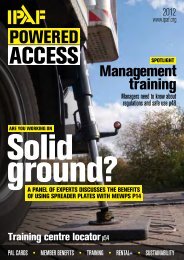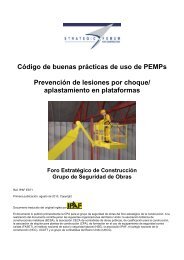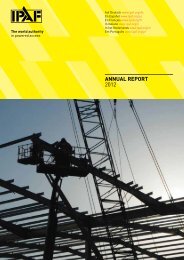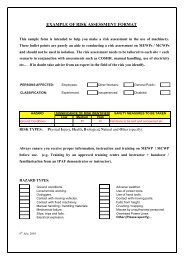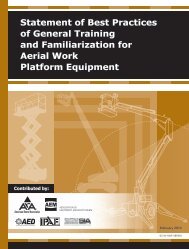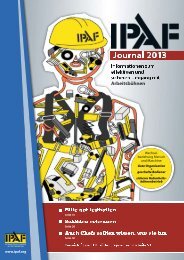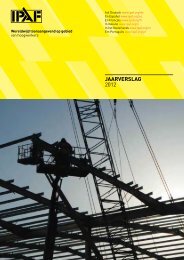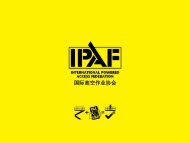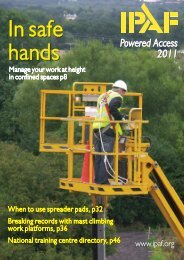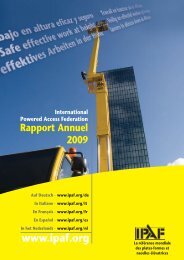IPAF Guidelines for the Safe Use of Mast Climbing Work Platforms
IPAF Guidelines for the Safe Use of Mast Climbing Work Platforms
IPAF Guidelines for the Safe Use of Mast Climbing Work Platforms
Create successful ePaper yourself
Turn your PDF publications into a flip-book with our unique Google optimized e-Paper software.
<strong>IPAF</strong> <strong>Guidelines</strong> <strong>for</strong> <strong>the</strong> <strong>Safe</strong><br />
<strong>Use</strong> <strong>of</strong> <strong>Mast</strong> <strong>Climbing</strong> <strong>Work</strong><br />
Plat<strong>for</strong>ms<br />
US Edition 2010<br />
REVIEWED AND ENDORSED BY<br />
<strong>IPAF</strong> Ref. USAO 07/10-002<br />
www.ipaf.org
<strong>IPAF</strong> <strong>Guidelines</strong> <strong>for</strong> <strong>the</strong> <strong>Safe</strong> <strong>Use</strong> <strong>of</strong> <strong>Mast</strong> <strong>Climbing</strong> <strong>Work</strong> Plat<strong>for</strong>ms:<br />
US Edition 2010<br />
Contents<br />
<strong>IPAF</strong> 2010<br />
Committees responsible<br />
Foreword<br />
Page<br />
Inside Front Cover<br />
i<br />
1. Scope 1<br />
2. Reference Standard 1<br />
3. Terms and Definitions 1<br />
4. Hazards Associated with MCWP Usage 9<br />
5. Specification, Installation Planning, Erection and Dismantling 9<br />
6. Management and Control <strong>of</strong> MCWP Operation 10<br />
7. Personnel and Training 10<br />
8. Planning <strong>of</strong> <strong>the</strong> Installation 12<br />
9. Positioning MCWPs 13<br />
10. Installation 15<br />
11. Operation, <strong>Use</strong>, Maintenance and Inspection 16<br />
12. Frequent Inspection and Testing <strong>of</strong> MCWPs 17<br />
13. <strong>Safe</strong>ty at <strong>the</strong> <strong>Work</strong>site 19<br />
Annex A Typical Checklists <strong>for</strong> Daily and Weekly Inspections 23<br />
Annex B Typical Checklists <strong>for</strong> Frequent inspections 24<br />
Annex C<br />
In<strong>for</strong>mation <strong>IPAF</strong> MCWP Templates 25<br />
<strong>IPAF</strong> MCWP Modular Training Matrix 26<br />
<strong>IPAF</strong> MCWP Operator Training Program 27<br />
Figure 1 – Typical Single <strong>Mast</strong> Mobile MCWP 6<br />
Figure 2 – Twin <strong>Mast</strong> MCWP illustrating fixed and mobile chassis 7<br />
Figure 3 – Typical mast tie arrangement 8<br />
Table 1 – MCWP Training Needs Analysis 4<br />
Table 2 – MCWP Training Needs Analysis 5<br />
1
<strong>IPAF</strong> <strong>Guidelines</strong> <strong>for</strong> <strong>the</strong> <strong>Safe</strong> <strong>Use</strong> <strong>of</strong> <strong>Mast</strong> <strong>Climbing</strong> <strong>Work</strong> Plat<strong>for</strong>ms:<br />
US Edition 2010<br />
Foreword<br />
This guideline has been prepared by <strong>the</strong> International Powered Access Federation (<strong>IPAF</strong>), as a<br />
result <strong>of</strong> requests from industry bodies, users and manufacturers. It has been based on<br />
proposals from <strong>IPAF</strong> using BS7981, and BS EN 1495, Lifting Plat<strong>for</strong>ms – <strong>Mast</strong> <strong>Climbing</strong> <strong>Work</strong><br />
Plat<strong>for</strong>ms and has subsequently been reviewed and endorsed by <strong>the</strong> Scaffold Industry<br />
Association (SIA). It also includes influences from <strong>the</strong> Center <strong>for</strong> Protection <strong>of</strong> <strong>Work</strong>ers Rights<br />
(CPWR) <strong>Mast</strong> Climbers Group, ANSI A92.9, OSHA 1926 Subpart L, ‘Scaffolds’, Cal OSHA’s<br />
specific MCWP guidance, and <strong>IPAF</strong>’s International MCWP Committee.<br />
<strong>Mast</strong> climbing work plat<strong>for</strong>ms (MCWPs) are increasingly being used as temporary work places,<br />
giving variable height access to specific areas above ground level. In many cases MCWPs are<br />
more convenient to use than o<strong>the</strong>r <strong>for</strong>ms <strong>of</strong> access equipment such as ladders, fixed<br />
scaffolding, or staging, or swingstage. Examples <strong>of</strong> MCWPs are shown in Figures 1, 2 and 3.<br />
This guideline sets out recommendations to ensure that MCWPs are installed, maintained,<br />
examined and used in a safe manner.<br />
Annex A, Annex B, and Annex C are in<strong>for</strong>mative.<br />
Compliance with this code does not <strong>of</strong> itself confer immunity from legal obligations.<br />
Summary <strong>of</strong> Pages<br />
This document comprises a front cover, an inside front cover, a contents page, page i, pages 1 to 27, and a back cover.<br />
2<br />
i
1. Scope<br />
This Guideline provides recommendations <strong>for</strong> persons responsible <strong>for</strong> <strong>the</strong> installation, maintenance and frequent<br />
inspection <strong>of</strong> MCWPs. It also provides recommendations on <strong>the</strong> safe use <strong>of</strong> MCWPs.<br />
This Guideline gives recommendations <strong>for</strong> MCWPs, which are temporarily and permanently installed, electrically or<br />
gas powered, and designed to be used by one or more person(s) from which to carry out work. The vertical moving<br />
components (work plat<strong>for</strong>m) are used to move those same persons and <strong>the</strong>ir equipment and materials to and from<br />
a single boarding point. These restrictions differentiate MCWPs from construction elevators.<br />
This Guideline gives recommendations <strong>for</strong> MCWPs including those that meet <strong>the</strong> requirements <strong>of</strong> ANSI A92.9.<br />
These MCWPs typically can be considered to consist <strong>of</strong> four assemblies, or groups <strong>of</strong> parts, as follows:<br />
a) At least one mast which is climbed by and which supports <strong>the</strong> plat<strong>for</strong>m.<br />
b) A work plat<strong>for</strong>m capable <strong>of</strong> supporting persons, equipment, tools and materials, etc.<br />
c) A wheeled chassis, or a base frame, supporting <strong>the</strong> mast structure.<br />
d) <strong>Mast</strong> tie assemblies.<br />
Notes:<br />
1. The chassis or base frame can provide stability <strong>for</strong> MCWPs up to a predetermined free-standing height, above which <strong>the</strong> mast(s) is<br />
tied to <strong>the</strong> building or o<strong>the</strong>r structure.<br />
2. Figure 1 shows a single mast mobile MCWP. Figure 2 shows a twin mast MCWP that, <strong>for</strong> illustrative purposes, shows examples <strong>of</strong> a<br />
fixed base and a mobile base. Twin mast machines on site ei<strong>the</strong>r have two fixed bases or two mobile chassis. Figure 3 shows typical<br />
mast tie arrangements.<br />
This Guideline does not give recommendations <strong>for</strong> dealing with <strong>the</strong> hazards involved in <strong>the</strong> maneuvering, erection<br />
or dismantling, fixing or removing <strong>of</strong> any materials or equipment which are not part <strong>of</strong> <strong>the</strong> MCWP. Nei<strong>the</strong>r does it<br />
deal with <strong>the</strong> handling <strong>of</strong> specific hazardous materials.<br />
This Guideline does not give recommendations <strong>for</strong> delivering persons and materials to fixed landing levels. Such<br />
equipment, referred to as lifts or hoists are dealt with by o<strong>the</strong>r standards such as ANSI A92.10 Transport Plat<strong>for</strong>ms,<br />
ANSI A10.4 Personnel Hoists and ANSI A10.5 Material Hoists, Mobile Elevating <strong>Work</strong> Plat<strong>for</strong>ms (MEWPs)<br />
con<strong>for</strong>ming to ANSI A92.5 Boom Lifts, and A92.6 Scissor Lifts.<br />
2. Reference Standard<br />
The following Standard contains provisions which, through reference in this text, constitute provisions <strong>of</strong> <strong>the</strong><br />
Guideline. For dated references, subsequent amendments to, or revisions <strong>of</strong>, any <strong>of</strong> <strong>the</strong>se publications do not<br />
apply. For undated references, <strong>the</strong> latest edition <strong>of</strong> <strong>the</strong> publication referred to applies.<br />
ANSI A92.9 <strong>Mast</strong>-<strong>Climbing</strong> <strong>Work</strong> Plat<strong>for</strong>ms<br />
3. Terms and Definitions<br />
For <strong>the</strong> purpose <strong>of</strong> this standard <strong>the</strong> following terms and definitions apply.<br />
3.1 Rated Load. Load <strong>for</strong> which an MCWP has been designed <strong>for</strong> in normal operation, as stated in <strong>the</strong> load<br />
diagram/chart.<br />
3.2 Rated Speed. Vertical or horizontal speed <strong>for</strong> which an MCWP has been designed.<br />
3.3 Transfer. Any horizontal movement <strong>of</strong> an MCWP from one position to ano<strong>the</strong>r on <strong>the</strong> same working site.<br />
3.4 Transport. Any movement <strong>of</strong> an MCWP outside <strong>the</strong> boundaries <strong>of</strong> <strong>the</strong> work site.<br />
3.5 Base Frame. Part <strong>of</strong> an MCWP that provides support <strong>for</strong> <strong>the</strong> mast and elevating assembly.<br />
1
<strong>IPAF</strong> <strong>Guidelines</strong> <strong>for</strong> <strong>the</strong> <strong>Safe</strong> <strong>Use</strong> <strong>of</strong> <strong>Mast</strong> <strong>Climbing</strong> <strong>Work</strong> Plat<strong>for</strong>ms:<br />
US Edition 2010<br />
3.6 Chassis. Part <strong>of</strong> an MCWP that provides mobility and support <strong>for</strong> <strong>the</strong> mast and elevating assembly.<br />
3.7 Jacks or Outriggers. Supports at <strong>the</strong> base frame level used to maintain or increase <strong>the</strong> stability <strong>of</strong> an<br />
MCWP within specified conditions. (note: <strong>the</strong>y may be used <strong>for</strong> leveling)<br />
3.8 <strong>Mast</strong>. Structure that supports and guides <strong>the</strong> plat<strong>for</strong>m.<br />
3.9 Guides. Parts <strong>of</strong> <strong>the</strong> mast which provide guiding <strong>for</strong> <strong>the</strong> plat<strong>for</strong>m.<br />
3.10 <strong>Mast</strong> Tie. Anchorage system used to provide lateral restraint to <strong>the</strong> mast from <strong>the</strong> building or o<strong>the</strong>r structure.<br />
3.11 <strong>Work</strong> Plat<strong>for</strong>m. Vertical, traveling, part <strong>of</strong> <strong>the</strong> installation upon which <strong>the</strong> persons, equipment and materials<br />
are carried, and from which, work is carried out. (Note: This is as opposed to an MCWP, which refers to <strong>the</strong><br />
whole <strong>of</strong> <strong>the</strong> installation, among o<strong>the</strong>rs, <strong>the</strong> work plat<strong>for</strong>m, mast, mast ties, base and chassis. The work<br />
plat<strong>for</strong>m includes <strong>the</strong> main plat<strong>for</strong>m and any plat<strong>for</strong>m extension.)<br />
3.12 Main Plat<strong>for</strong>m. Part <strong>of</strong> <strong>the</strong> work plat<strong>for</strong>m that is built up using primary structural elements.<br />
3.13 Buffer. Resilient stop at <strong>the</strong> end <strong>of</strong> <strong>the</strong> travel, comprising a means <strong>of</strong> arresting using fluids, springs or similar<br />
means.<br />
3.14 Overspeed. Any speed above rated speed.<br />
3.15 <strong>Safe</strong>ty Mechanism. Mechanical device <strong>for</strong> stopping and maintaining <strong>the</strong> work plat<strong>for</strong>m stationary on <strong>the</strong> mast<br />
in <strong>the</strong> event <strong>of</strong> overspeed.<br />
3.16 Competent Person. Person who is capable <strong>of</strong> identifying existing and predictable hazards in <strong>the</strong><br />
surroundings or working conditions which are unsanitary, hazardous, or dangerous to employees, and who<br />
has authorization to take prompt corrective measures to eliminate <strong>the</strong>m.(OSHA 1926 Subpart L)<br />
3.17 Qualified Person. Person who, by possession <strong>of</strong> a recognized degree, certificate, or pr<strong>of</strong>essional standing,<br />
or who by extensive knowledge, training and experience, has successfully demonstrated his/her ability to<br />
solve, or resolve, problems related to <strong>the</strong> subject matter, <strong>the</strong> work, or <strong>the</strong> project.(OSHA 1926 Subpart L)<br />
3.18 Supplier Competent Person. Person appointed by <strong>the</strong> MCWP supplier who is responsible <strong>for</strong> planning <strong>the</strong><br />
installation, method statements <strong>for</strong> <strong>the</strong> erection, safe operation, inspection, maintenance, frequent inspection<br />
and dismantling <strong>of</strong> MCWPs.<br />
3.19 <strong>Use</strong>r Competent Person. Person appointed by <strong>the</strong> user company who is responsible <strong>for</strong> devising safe<br />
systems <strong>of</strong> work and o<strong>the</strong>r aspects <strong>of</strong> use to be carried out from MCWPs.<br />
3.20 Installer. Person(s) responsible <strong>for</strong> installation, including erection, modification, and dismantling <strong>of</strong> MCWPs.<br />
3.21 Demonstrator. Person(s) responsible <strong>for</strong> <strong>the</strong> on-site management <strong>of</strong> safe use, inspection, servicing and<br />
maintenance <strong>of</strong> MCWPs, and <strong>the</strong> familiarization <strong>of</strong> operators on <strong>the</strong> job site.<br />
2
<strong>IPAF</strong> <strong>Guidelines</strong> <strong>for</strong> <strong>the</strong> <strong>Safe</strong> <strong>Use</strong> <strong>of</strong> <strong>Mast</strong> <strong>Climbing</strong> <strong>Work</strong> Plat<strong>for</strong>ms:<br />
US Edition 2010<br />
3.22 <strong>Use</strong>r. Person(s) or entity that utilizes, or puts into operation, an MCWP.<br />
3.23 Operator. A qualified person (ANSI A92.9 definition), who controls <strong>the</strong> movement <strong>of</strong> an erected MCWP.<br />
3.24 Mobile MCWP installation. MCWP installation with no more than two ties, which is suitably designed <strong>for</strong><br />
horizontal transfer on <strong>the</strong> job site.<br />
3
<strong>IPAF</strong> <strong>Guidelines</strong> <strong>for</strong> <strong>the</strong> <strong>Safe</strong> <strong>Use</strong> <strong>of</strong> <strong>Mast</strong> <strong>Climbing</strong> <strong>Work</strong> Plat<strong>for</strong>ms:<br />
US Edition 2010<br />
4
<strong>IPAF</strong> <strong>Guidelines</strong> <strong>for</strong> <strong>the</strong> <strong>Safe</strong> <strong>Use</strong> <strong>of</strong> <strong>Mast</strong> <strong>Climbing</strong> <strong>Work</strong> Plat<strong>for</strong>ms:<br />
US Edition 2010<br />
5
<strong>IPAF</strong> <strong>Guidelines</strong> <strong>for</strong> <strong>the</strong> <strong>Safe</strong> <strong>Use</strong> <strong>of</strong> <strong>Mast</strong> <strong>Climbing</strong> <strong>Work</strong> Plat<strong>for</strong>ms:<br />
US Edition 2010<br />
Figure 1<br />
Typical Single <strong>Mast</strong> Mobile<br />
MCWP<br />
Note: Base protection omitted <strong>for</strong><br />
clarity<br />
6
<strong>IPAF</strong> <strong>Guidelines</strong> <strong>for</strong> <strong>the</strong> <strong>Safe</strong> <strong>Use</strong> <strong>of</strong> <strong>Mast</strong> <strong>Climbing</strong> <strong>Work</strong> Plat<strong>for</strong>ms:<br />
US Edition 2010<br />
Figure 2 – Twin <strong>Mast</strong> MCWP illustrating one fixed and one mobile chassis<br />
Note: Base Protection Removed For Clarity<br />
7
<strong>IPAF</strong> <strong>Guidelines</strong> <strong>for</strong> <strong>the</strong> <strong>Safe</strong> <strong>Use</strong> <strong>of</strong> <strong>Mast</strong> <strong>Climbing</strong> <strong>Work</strong> Plat<strong>for</strong>ms:<br />
US Edition 2010<br />
Figure 3 – Typical <strong>Mast</strong> Tie Arrangements<br />
8
<strong>IPAF</strong> <strong>Guidelines</strong> <strong>for</strong> <strong>the</strong> <strong>Safe</strong> <strong>Use</strong> <strong>of</strong> <strong>Mast</strong> <strong>Climbing</strong> <strong>Work</strong> Plat<strong>for</strong>ms:<br />
US Edition 2010<br />
4. Hazards Associated with MCWP <strong>Work</strong>ing<br />
4.1 General<br />
Section 4 is intended to assist those persons undertaking risk assessments <strong>of</strong> <strong>the</strong> installation planning, erection,<br />
dismantling and use <strong>of</strong> MCWPs.<br />
4.2 Erection and Dismantling<br />
Potential hazards that should be considered when installing or dismantling MCWPs, <strong>the</strong>se hazards include but are<br />
not limited to <strong>the</strong> following:<br />
a) Handling heavy items<br />
b) Improper mast bolt connections<br />
c) Exposure to dust and particles during <strong>the</strong> drilling <strong>of</strong> mast tie anchorages<br />
d) Improper mast tie installation<br />
e) Improper mast installation<br />
f) Moving parts<br />
g) Improper dismantling procedures<br />
h) Fall hazards on building or plat<strong>for</strong>m<br />
4.3 <strong>Use</strong><br />
Potential hazards that should be considered when using MCWPs, <strong>the</strong>se hazards include but are not limited to <strong>the</strong><br />
following:<br />
a) Fall hazard from <strong>the</strong> work plat<strong>for</strong>m<br />
b) Falling objects<br />
c) Crushing hazard beneath a MCWP<br />
d) Trapping <strong>of</strong> persons between <strong>the</strong> work plat<strong>for</strong>m and fixed obstructions, such as <strong>the</strong> building or scaffolding<br />
e) Instability <strong>of</strong> a free standing MCWP<br />
f) Loss <strong>of</strong> power or control circuit failure<br />
g) Contact with live electrical conductors<br />
h) Improper inspections<br />
i) Overturning hazard during <strong>the</strong> transfer <strong>of</strong> mobile MCWPs<br />
5. Specification, installation planning, erecting and dismantling <strong>of</strong> MCWPs<br />
5.1 General<br />
One person, <strong>the</strong> supplier competent person (see 3.18), should be appointed to act on behalf <strong>of</strong> <strong>the</strong> supplier to have<br />
overall control <strong>of</strong> <strong>the</strong> specification, installation planning, erecting and dismantling <strong>of</strong> MCWPs. The person appointed<br />
may have o<strong>the</strong>r duties and need not be an employee <strong>of</strong> <strong>the</strong> supplier organization, but should have adequate<br />
training and experience to enable <strong>the</strong>se duties to be carried out competently.<br />
5.2 Responsibilities <strong>of</strong> Supplier Competent Person<br />
The Supplier Competent Person should establish and follow a safe system <strong>of</strong> work <strong>for</strong> every installation <strong>of</strong> an<br />
MCWP, whe<strong>the</strong>r it is an individual machine or a group <strong>of</strong> machines. The same principles should be applied to both<br />
fixed and mobile MCWPs.<br />
The safe system <strong>of</strong> work should include <strong>the</strong> following:<br />
a) Assessment <strong>of</strong> hazards<br />
b) Planning <strong>the</strong> installation and providing a suitable MCWP<br />
c) Planning <strong>the</strong> erection and dismantling <strong>of</strong> each MCWP<br />
d) Provide instructions <strong>for</strong> <strong>the</strong> operation and maintenance procedures <strong>for</strong> MCWPs<br />
e) Preparation <strong>of</strong> a project plan, including <strong>the</strong> requirements <strong>for</strong>:<br />
9
<strong>IPAF</strong> <strong>Guidelines</strong> <strong>for</strong> <strong>the</strong> <strong>Safe</strong> <strong>Use</strong> <strong>of</strong> <strong>Mast</strong> <strong>Climbing</strong> <strong>Work</strong> Plat<strong>for</strong>ms:<br />
US Edition 2010<br />
1) Any necessary preparation <strong>of</strong> <strong>the</strong> jobsite<br />
2) Erection<br />
3) Frequent inspection and, where necessary, testing<br />
4) Provision instructions <strong>for</strong> operations<br />
5) Dismantling<br />
f) Ensure that <strong>the</strong>re are properly trained and competent personnel <strong>for</strong> <strong>the</strong> installation and demonstration <strong>of</strong><br />
MCWPs, who have been made aware <strong>of</strong> <strong>the</strong>ir statutory responsibilities<br />
g) Ensuring that all necessary instructions, manuals, test certificates, load charts and o<strong>the</strong>r documents are<br />
available<br />
h) Effective communication with <strong>the</strong> <strong>Use</strong>r Company<br />
The safe system <strong>of</strong> work should be communicated to all parties concerned, and monitored.<br />
6. Management and control <strong>of</strong> MCWP operation<br />
6.1 General<br />
One person, <strong>the</strong> <strong>Use</strong>r Company Competent Person (see 3.19), should be appointed to act on behalf <strong>of</strong> <strong>the</strong> user<br />
organization to have overall control <strong>of</strong> each specific MCWP operation. This appointment does not remove any legal<br />
responsibility from <strong>the</strong> management but enables <strong>the</strong>m to use his or her expertise to fulfill <strong>the</strong>ir responsibilities. The<br />
person appointed may have o<strong>the</strong>r duties and need not be an employee <strong>of</strong> <strong>the</strong> user organization but should have<br />
adequate training and experience to enable <strong>the</strong>se duties to be carried out competently.<br />
The training requirements <strong>for</strong> <strong>the</strong> <strong>Use</strong>r Company Competent Person are given in Table 1.<br />
6.2 Responsibilities <strong>of</strong> <strong>the</strong> <strong>Use</strong>r Company Competent Person<br />
The <strong>Use</strong>r Company Competent Person should establish and follow a safe system <strong>of</strong> work <strong>for</strong> every use <strong>of</strong> a mast<br />
climbing work plat<strong>for</strong>m, whe<strong>the</strong>r it is an individual machine or a group <strong>of</strong> machines. The same principles should be<br />
applied to both fixed and mobile MCWPs.<br />
The safe system <strong>of</strong> work should include <strong>the</strong> following:<br />
a) Assessment <strong>of</strong> hazards<br />
b) The familiarization <strong>of</strong> <strong>the</strong> operators <strong>of</strong> <strong>the</strong> MCWP<br />
c) The preparation <strong>of</strong> a project plan <strong>for</strong> <strong>the</strong> work to be carried out on <strong>the</strong> plat<strong>for</strong>m, including emergency<br />
egress<br />
d) The inspection and maintenance <strong>of</strong> MCWPs in accordance with <strong>the</strong> suppliers instructions<br />
e) Provide <strong>for</strong> adequate supervision by properly trained and competent personnel having <strong>the</strong> necessary<br />
authority<br />
f) Prevent unauthorized use or movement <strong>of</strong> MCWPs at all times<br />
g) Consideration <strong>for</strong> <strong>the</strong> safety <strong>of</strong> personnel working near <strong>the</strong> MCWP<br />
h) Arrangements <strong>for</strong> <strong>the</strong> effective monitoring <strong>of</strong> wind speed<br />
i) Effective liaison with <strong>the</strong> supplier competent person.<br />
The safe system <strong>of</strong> work should be communicated to all parties concerned, and monitored<br />
7. Personnel and Training<br />
7.1 Selection<br />
Suitable personnel, who are competent to carry out all duties required, should be selected to carry out <strong>the</strong><br />
operations safely. Records <strong>of</strong> training and experience <strong>of</strong> persons should be consulted to assist in selection.<br />
Persons responsible <strong>for</strong> selection <strong>of</strong> personnel should ensure that personnel are effectively organized to ensure<br />
good teamwork. Personnel should not be under <strong>the</strong> influence <strong>of</strong> alcohol, drugs or o<strong>the</strong>r impairments to efficiency.<br />
All personnel should be aware <strong>of</strong> <strong>the</strong>ir duties. Personnel undergoing training should be properly supervised.<br />
10
<strong>IPAF</strong> <strong>Guidelines</strong> <strong>for</strong> <strong>the</strong> <strong>Safe</strong> <strong>Use</strong> <strong>of</strong> <strong>Mast</strong> <strong>Climbing</strong> <strong>Work</strong> Plat<strong>for</strong>ms:<br />
US Edition 2010<br />
7.2 Minimum attributes <strong>of</strong> personnel<br />
All personnel should be:<br />
a) Competent to per<strong>for</strong>m tasks required <strong>of</strong> <strong>the</strong>m<br />
b) Trained and/or evaluated<br />
c) Able to present a record <strong>of</strong> training and/or evaluation<br />
d) Physically able to undertake appointed tasks<br />
7.3 Training requirements<br />
Every employer is responsible <strong>for</strong> determining <strong>the</strong> training requirements <strong>of</strong>, and providing safety equipment <strong>for</strong>, and<br />
training to, all personnel.<br />
Training will include, but is not limited to:<br />
a) MCWP specification/configuration<br />
b) Installation planning<br />
c) Erection and dismantling<br />
d) Operation, use and inspection<br />
e) Maintenance<br />
f) Testing and examination<br />
Table 1 gives <strong>the</strong> training needs analysis relating to <strong>the</strong> above tasks.<br />
11
<strong>IPAF</strong> <strong>Guidelines</strong> <strong>for</strong> <strong>the</strong> <strong>Safe</strong> <strong>Use</strong> <strong>of</strong> <strong>Mast</strong> <strong>Climbing</strong> <strong>Work</strong> Plat<strong>for</strong>ms:<br />
US Edition 2010<br />
8 Planning <strong>the</strong> Installation<br />
8.1 General<br />
No one should be responsible <strong>for</strong> specifying MCWPs, or planning an installation, or alteration to an installation,<br />
unless <strong>the</strong>y are competent in this work. Such competence will have been gained by appropriate training and<br />
relevant experience under supervision, and may be verified by entries in <strong>the</strong>ir record <strong>of</strong> attainment.<br />
Plans should be periodically reviewed in <strong>the</strong> light <strong>of</strong> changing site circumstances.<br />
8.2 Planning<br />
In selecting an MCWP and planning <strong>the</strong> installation, <strong>the</strong> Supplier Competent Person should refer to <strong>the</strong> MCWP<br />
operating specification and installation instructions provided by <strong>the</strong> manufacturer. A site survey is necessary.<br />
A checklist <strong>for</strong> <strong>the</strong> site survey should include <strong>the</strong> following:<br />
a) Establish primary purpose that MCWPs will be used <strong>for</strong> with <strong>the</strong> client at <strong>the</strong> outset, toge<strong>the</strong>r with any<br />
o<strong>the</strong>r additional requirements <strong>the</strong>re might be <strong>for</strong> <strong>the</strong> unit, e.g. prevention <strong>of</strong> falling debris<br />
b) Length <strong>of</strong> work plat<strong>for</strong>m required and <strong>the</strong> work plat<strong>for</strong>m configuration, including any edge extensions, <strong>for</strong><br />
<strong>the</strong> full duration <strong>of</strong> <strong>the</strong> installation.<br />
c) <strong>Mast</strong> positions<br />
d) Maximum height <strong>of</strong> travel<br />
e) <strong>Work</strong> plat<strong>for</strong>m loading capacity and method <strong>of</strong> loading, to be agreed with <strong>the</strong> management/user<br />
f) Access and egress <strong>of</strong> personnel and materials<br />
g) Ground/supporting base conditions (levels and load bearing capacity)<br />
h) Area conditions around base with particular relevance if an MCWP is mobile and is to be moved while on<br />
site<br />
i) Tie fixing point strengths and fixing point details on <strong>the</strong> structure, including suitable means <strong>of</strong> access to<br />
such points <strong>for</strong> installation and dismantling<br />
j) An assessment (by <strong>the</strong> <strong>Use</strong>r Competent Person), will be necessary, <strong>of</strong> <strong>the</strong> strength <strong>of</strong> <strong>the</strong> structure both<br />
horizontally and vertically to support MCWPs.<br />
k) Uninsulated electrical conductors in <strong>the</strong> vicinity <strong>of</strong> MCWPs should be adequately shielded/moved.<br />
l) Windows or doors opening into path <strong>of</strong> work plat<strong>for</strong>m. Will an MCWP block any fire escape routes?<br />
m) Balconies or voids that necessitate special guarding methods or create special trapping hazards<br />
n) Are <strong>the</strong> power supply and connection arrangements (if applicable) suitably located with adequate earth<br />
protection and power capacity?<br />
o) Extent <strong>of</strong> ground level fencing <strong>of</strong> MCWP requirements, when required by risk assessment<br />
p) Access provisions to and from site <strong>for</strong> MCWPs – details/obstacles. In addition suitable task lighting should<br />
be available <strong>for</strong> <strong>the</strong>se operations<br />
q) Transfer clearances <strong>for</strong> mobile MCWP movement<br />
r) Are <strong>the</strong>re any cable snagging hazards (if applicable)?<br />
s) Access provision <strong>for</strong> maintenance<br />
8.3 Method Statement<br />
Details gained during <strong>the</strong> site survey should be used to compile a clear written method statement describing <strong>the</strong><br />
safe system <strong>of</strong> work <strong>for</strong> erection and dismantling. This should be a comprehensive, job-specific procedure <strong>for</strong> <strong>the</strong><br />
work to be carried out, and should include such in<strong>for</strong>mation, explanations, detail and diagrams that all concerned<br />
with <strong>the</strong> authorization, erection and dismantle are clear <strong>of</strong> <strong>the</strong>ir specific duties. It should also include or make<br />
reference to <strong>the</strong> risk assessments <strong>for</strong> all activities connected with <strong>the</strong> delivery, site handling, erection, use,<br />
dismantling and collection <strong>of</strong> MCWPs. This method statement should be issued and understood by all involved in<br />
<strong>the</strong> installation/dismantling <strong>of</strong> MCWPs.<br />
12
<strong>IPAF</strong> <strong>Guidelines</strong> <strong>for</strong> <strong>the</strong> <strong>Safe</strong> <strong>Use</strong> <strong>of</strong> <strong>Mast</strong> <strong>Climbing</strong> <strong>Work</strong> Plat<strong>for</strong>ms:<br />
US Edition 2010<br />
9 Positioning <strong>of</strong> MCWPs<br />
9.1 General<br />
MCWPs should only be used on suitable surfaces that are level and firm, and within <strong>the</strong> tolerances specified by <strong>the</strong><br />
manufacturer. Where <strong>the</strong> ground is o<strong>the</strong>r than well made concrete (or similar) in good condition, suitable load<br />
spreading plates should be used under base, and <strong>the</strong>se should be specified in <strong>the</strong> method statement and verified<br />
by a competent or qualified person. A suitable supply <strong>of</strong> metal or cribbing should be included in <strong>the</strong> inventory <strong>of</strong><br />
parts to be sent to site with MCWP’, or agreed <strong>for</strong> <strong>the</strong> site to provide.<br />
Special care should be taken in assessing <strong>the</strong> strength <strong>of</strong> ro<strong>of</strong>/floor members, and spreading <strong>the</strong> load adequately, if<br />
MCWPs are to be supported o<strong>the</strong>r than directly on <strong>the</strong> ground.<br />
If MCWPs are to be supported on cantilevered I-beam arrangements or ‘shelf brackets’, which are not designed<br />
and installed by <strong>the</strong> manufacturer, <strong>the</strong> base support should be evaluated and approved by a person qualified in<br />
structural engineering, with due consideration <strong>of</strong> all gravity and lateral loads.<br />
Plat<strong>for</strong>m wea<strong>the</strong>r enclosures, tarps, signs, or any o<strong>the</strong>r construction which could affect <strong>the</strong> wind load on <strong>the</strong><br />
plat<strong>for</strong>m, outwith <strong>the</strong> pre-determined manufacturers specifications, should be authorized only by <strong>the</strong> manufacturer.<br />
If <strong>the</strong> MCWP is to be placed on concrete floors/ro<strong>of</strong>s requiring additional structural supports underneath (e.g.<br />
underground car park levels), a ‘competent’ or ‘qualified’ person should provide:<br />
1. Calculations showing <strong>the</strong> specific ground load(s) to be shored <strong>for</strong> <strong>the</strong> configuration in question.<br />
2. The type, amount and load rating <strong>of</strong> <strong>the</strong> shoring posts.<br />
3. A shoring plan, detailing <strong>the</strong> exact position <strong>of</strong> each post, <strong>for</strong> each level, relevant to column lines.<br />
4. A means <strong>of</strong> making sure that <strong>the</strong> posts are protected against inadvertent removal or damage (e.g. signage,<br />
‘safety tape’ etc refer to section 13.13 <strong>for</strong> more detail).<br />
In specifying <strong>the</strong> base frame or chassis, care should be taken to ensure that it will provide adequate stability be<strong>for</strong>e<br />
<strong>the</strong> mast ties are secured during erection, and after <strong>the</strong> mast ties have been removed during dismantle.<br />
The mast(s) should be tied to structural members <strong>of</strong> <strong>the</strong> building unless adequate strength <strong>of</strong> alternative tie<br />
locations can be assured (typical tie fixings are shown in fig. 3). The building or structure should be assessed to<br />
ensure that it can withstand <strong>the</strong> loads imposed by MCWPs, <strong>the</strong> load parameters to be provided by <strong>the</strong> Supplier<br />
Competent Person to <strong>the</strong> <strong>Use</strong>r Competent Person.<br />
The possible effects, on MCWPs, <strong>of</strong> all reasonably <strong>for</strong>eseeable wea<strong>the</strong>r conditions (i.e. high winds) <strong>for</strong> <strong>the</strong> duration<br />
<strong>of</strong> <strong>the</strong> installation and erection and dismantling, should be taken into account. Additionally, MCWPs should not be<br />
positioned where <strong>the</strong>y are likely to be struck by site or o<strong>the</strong>r vehicles or by unrestrained swinging loads. Protection<br />
<strong>of</strong> installed MCWPs from interference by unauthorized personnel should also be considered.<br />
If designated fire escapes will be obstructed, this should be reconciled with <strong>the</strong> local Fire Authority (see also section<br />
headed ‘<strong>Safe</strong>ty at <strong>the</strong> <strong>Work</strong> Site’ below).<br />
9.2 Access to <strong>the</strong> plat<strong>for</strong>m at <strong>the</strong> boarding point<br />
9.2.1 General<br />
<strong>Safe</strong> and convenient means <strong>of</strong> access should be provided to <strong>the</strong> work plat<strong>for</strong>m. This should be from one level only.<br />
If a raised fixed landing is provided <strong>for</strong> access to <strong>the</strong> work plat<strong>for</strong>m, <strong>the</strong>n care should be taken not to create a foottrapping<br />
hazard. If this landing is at height and <strong>the</strong> possibility <strong>of</strong> falling exists <strong>the</strong>n it should be protected when a<br />
MCWP is not at <strong>the</strong> access landing position.<br />
9.2.2 Sites accessible to <strong>the</strong> public<br />
13
<strong>IPAF</strong> <strong>Guidelines</strong> <strong>for</strong> <strong>the</strong> <strong>Safe</strong> <strong>Use</strong> <strong>of</strong> <strong>Mast</strong> <strong>Climbing</strong> <strong>Work</strong> Plat<strong>for</strong>ms:<br />
US Edition 2010<br />
Where MCWPs are erected in a place accessible to <strong>the</strong> public, access to <strong>the</strong> MCWPs should be prevented by<br />
fencing at ground level to a height <strong>of</strong> at least 6ft. The <strong>Use</strong>r Competent Person shall ensure that <strong>the</strong> fencing is<br />
properly maintained and kept in place.<br />
9.2.3 Sites not accessible to <strong>the</strong> public<br />
9.2.3.1 General<br />
Where MCWPs are erected within a construction site bounded by perimeter fencing that prevents public access,<br />
<strong>the</strong> <strong>Use</strong>r Competent Person, with <strong>the</strong> assistance <strong>of</strong> <strong>the</strong> Supplier Competent Person, shall conduct a risk<br />
assessment to determine <strong>the</strong> safeguarding arrangements required to prevent and/or reduce <strong>the</strong> risk <strong>of</strong> injury <strong>of</strong>:<br />
a) Being trapped and/or crushed by <strong>the</strong> descending plat<strong>for</strong>m<br />
b) Being struck by falling debris<br />
The <strong>Use</strong>r Competent Person should consult with <strong>the</strong> Supplier Competent Person and review <strong>the</strong> risk assessment<br />
whenever <strong>the</strong>re is any change <strong>of</strong> work practice at <strong>the</strong> base <strong>of</strong> <strong>the</strong> plat<strong>for</strong>m <strong>for</strong> <strong>the</strong> duration <strong>of</strong> <strong>the</strong> installation.<br />
9.2.3.2 Risk <strong>of</strong> crushing and/or trapping<br />
The risk assessment shall take into account <strong>the</strong> following factors:<br />
a) How frequently is it intended that <strong>the</strong> plat<strong>for</strong>m will descend to ground level?<br />
b) For mobile MCWPs, how frequently will <strong>the</strong> machine be transferred to a new location?<br />
c) The location <strong>of</strong> any trapping points between <strong>the</strong> descending plat<strong>for</strong>m and <strong>the</strong> structure, and <strong>the</strong> severity <strong>of</strong><br />
<strong>the</strong> injury that could occur.<br />
d) The safety devices provided on an MCWP: MCWPs constructed in accordance with ANSI A92.9 are<br />
provided ei<strong>the</strong>r with adequate guarding or where that is not possible, operate an audible alarm during <strong>the</strong><br />
final descent. The <strong>Use</strong>r Competent Person’s risk assessment should take into account <strong>the</strong> effectiveness <strong>of</strong><br />
any such alarms fitted. Will workers at ground level hear <strong>the</strong> audible alarm above <strong>the</strong> background noise,<br />
such as passing vehicles?<br />
e) Will <strong>the</strong> MCWP user have good visibility <strong>of</strong> <strong>the</strong> area underneath <strong>the</strong> length <strong>of</strong> <strong>the</strong> plat<strong>for</strong>m?<br />
Where <strong>the</strong> risks are assessed to be low, <strong>for</strong> instance where <strong>the</strong> frequency <strong>of</strong> descent <strong>of</strong> <strong>the</strong> plat<strong>for</strong>m to ground level<br />
is less than once per hour, <strong>the</strong> machine alarms are assessed as satisfactory, and <strong>the</strong> MCWP user has<br />
unobstructed visibility, <strong>the</strong>n localized low barriers can be provided to deter access. These barriers should be robust,<br />
such as scaffold frames or proprietary systems similar to those used <strong>for</strong> protecting around road works. Caution tape<br />
and rope or chains is not suitable. Signs warning <strong>of</strong> <strong>the</strong> descent <strong>of</strong> <strong>the</strong> plat<strong>for</strong>m should be erected.<br />
The <strong>Use</strong>r Competent Person shall ensure that <strong>the</strong> fencing is properly maintained and kept in place.<br />
9.2.3.3 Risk <strong>of</strong> being struck by falling objects<br />
Prevention <strong>of</strong> objects falling from <strong>the</strong> work plat<strong>for</strong>m is best addressed in <strong>the</strong> system <strong>of</strong> work adopted on <strong>the</strong> plat<strong>for</strong>m<br />
and will vary depending on application. For example, concrete spraying/chipping would require <strong>the</strong> plat<strong>for</strong>m to be<br />
fitted with solid or mesh plat<strong>for</strong>m sides.<br />
There can be a risk <strong>of</strong> falling objects to <strong>the</strong> personnel working in <strong>the</strong> plat<strong>for</strong>m, which should be assessed.<br />
Devices such as nets and fans can be utilized ei<strong>the</strong>r on <strong>the</strong> plat<strong>for</strong>m or at o<strong>the</strong>r levels to collect falling objects.<br />
14
<strong>IPAF</strong> <strong>Guidelines</strong> <strong>for</strong> <strong>the</strong> <strong>Safe</strong> <strong>Use</strong> <strong>of</strong> <strong>Mast</strong> <strong>Climbing</strong> <strong>Work</strong> Plat<strong>for</strong>ms:<br />
US Edition 2010<br />
9.3 Traffic Access<br />
If <strong>the</strong> base <strong>of</strong> an MCWP is erected in an area accessible by vehicles, arrangements should be made to divert traffic<br />
and secure <strong>the</strong> area against vehicle incursion, if this is reasonably practical. If not, <strong>the</strong>n suitable curbs, barriers,<br />
cones, lights, signs etc, should be provided in accordance with <strong>the</strong> method statement prepared by <strong>the</strong> <strong>Use</strong>r<br />
Competent Person.<br />
10 Installation<br />
10.1 Installation personnel<br />
No one should be allowed to erect or dismantle an MCWP unless <strong>the</strong>y are trained and authorized to do so, or are<br />
undergoing <strong>for</strong>mal training under supervision. Training and assessment should be carried out to a <strong>for</strong>mally<br />
documented scheme (see clause 7).<br />
All personnel carrying out <strong>the</strong> erection or dismantling <strong>of</strong> MCWPs should be physically and mentally fit to undertake<br />
this work. This should be assessed at <strong>the</strong> pre-employment stage with <strong>the</strong> advice <strong>of</strong> an occupational health<br />
pr<strong>of</strong>essional.<br />
10.2 Erection<br />
Personnel carrying out <strong>the</strong> erection <strong>of</strong> MCWPs should ensure that <strong>the</strong>y obtain a clear method statement produced<br />
by <strong>the</strong> Supplier Competent Person who planned <strong>the</strong> job. They should familiarize <strong>the</strong>mselves with <strong>the</strong> task to be<br />
carried out, raising any areas <strong>of</strong> concern or lack <strong>of</strong> clarity with <strong>the</strong> method statement originator. Be<strong>for</strong>e starting work<br />
<strong>the</strong>y should also ensure that <strong>the</strong>y have <strong>the</strong> required in<strong>for</strong>mation, tools and equipment, and that any safety<br />
measures such as exclusion zones around <strong>the</strong> work area are in place. If any guarding is required to be removed<br />
during erection, a safe system <strong>of</strong> work should be adopted with particular attention to hazards.<br />
The installer must be aware <strong>of</strong> <strong>the</strong> maximum load capacity <strong>of</strong> <strong>the</strong> work plat<strong>for</strong>m during all stages<br />
erection/dismantling and take into account <strong>the</strong> number <strong>of</strong> persons, mast sections, ties and o<strong>the</strong>r equipment on <strong>the</strong><br />
deck at any time. It is essential that <strong>the</strong> maximum load is not exceeded in any circumstance.<br />
If at any stage during <strong>the</strong> erection process, <strong>the</strong> installer encounters any problems with <strong>the</strong> prescribed method, or is<br />
concerned about any aspect <strong>of</strong> <strong>the</strong> method statement, <strong>the</strong>y should consult <strong>the</strong> method statement originator (usually<br />
<strong>the</strong> Supplier Competent Person) be<strong>for</strong>e proceeding any fur<strong>the</strong>r. In any case, no significant change to <strong>the</strong> planned<br />
method should be made unless it has been considered and agreed by a person competent to plan MCWP<br />
installations.<br />
It is vital that installers do not allow <strong>the</strong>ir attention to be distracted from any unsecured mast section on <strong>the</strong> mast<br />
assembly until that section has been completely bolted (or o<strong>the</strong>rwise fixed) in place. A number <strong>of</strong> accidents have<br />
occurred in <strong>the</strong> past where mast sections have been left unsecured or partially secured, and <strong>the</strong> plat<strong>for</strong>m has been<br />
subsequently driven onto <strong>the</strong> unsecured mast with disastrous consequences.<br />
After <strong>the</strong> installation has been completed and be<strong>for</strong>e an MCWP is taken into use, <strong>the</strong> installer should ensure <strong>the</strong><br />
following:<br />
a) That <strong>the</strong> installation is complete<br />
b) That <strong>the</strong> MCWP is not fouling <strong>the</strong> structure anywhere in its travel<br />
c) That all mast sections and mast ties are secure<br />
d) That all safety interlocks, including limit switches, are working correctly<br />
e) That all electricity supply cable is coiling or reeling correctly (if applicable)<br />
f) That <strong>the</strong> MCWP is responding correctly to <strong>the</strong> controls<br />
g) That <strong>the</strong> MCWP has been thoroughly examined and tested in accordance with section 12<br />
h) That <strong>the</strong> correct rated load <strong>for</strong> <strong>the</strong> configuration is clearly and durably marked on <strong>the</strong> work plat<strong>for</strong>m<br />
i) That all guards are re-installed correctly<br />
15
<strong>IPAF</strong> <strong>Guidelines</strong> <strong>for</strong> <strong>the</strong> <strong>Safe</strong> <strong>Use</strong> <strong>of</strong> <strong>Mast</strong> <strong>Climbing</strong> <strong>Work</strong> Plat<strong>for</strong>ms:<br />
US Edition 2010<br />
10.3 Alteration<br />
Once <strong>the</strong> initial installation has been completed in accordance with <strong>the</strong> method statement, no modification to <strong>the</strong><br />
installation should be allowed without a reassessment by a competent and authorized person (usually <strong>the</strong> Supplier<br />
Competent Person). This should include a full study <strong>of</strong> <strong>the</strong> proposed modification, implications <strong>for</strong> safety during <strong>the</strong><br />
remainder <strong>of</strong> <strong>the</strong> MCWP’s planned use, and its subsequent dismantling.<br />
Be<strong>for</strong>e starting any alterations to <strong>the</strong> installation <strong>the</strong> installers should be in possession <strong>of</strong> written authorization, or,<br />
where appropriate, a new method statement from <strong>the</strong> person making <strong>the</strong> reassessment.<br />
10.4 Dismantling<br />
Be<strong>for</strong>e dismantling an MCWP, <strong>the</strong> persons carrying out <strong>the</strong> dismantling operation should check <strong>the</strong> following:<br />
a) That <strong>the</strong>re have been no significant changes from <strong>the</strong> original installation that might adversely affect <strong>the</strong><br />
safety <strong>of</strong> <strong>the</strong> dismantling operation (e.g. missing or loose mast ties or fixing bolts, changed ground<br />
conditions or alterations to <strong>the</strong> base frame).<br />
b) That <strong>the</strong>re are no visible signs <strong>of</strong> stress or weakness in <strong>the</strong> MCWP or ties which might affect <strong>the</strong> safety <strong>of</strong><br />
<strong>the</strong> dismantling operation.<br />
c) That <strong>the</strong> base frame or chassis will provide sufficient stability, in all directions, when <strong>the</strong> last mast tie has<br />
been released.<br />
d) That <strong>the</strong> maximum number <strong>of</strong> mast ties and additional equipment that can be carried by <strong>the</strong> work plat<strong>for</strong>m,<br />
and <strong>the</strong>ir required distribution such as not to exceed <strong>the</strong> rated load, is known by all those taking part in <strong>the</strong><br />
dismantling.<br />
During <strong>the</strong> dismantling, special care should be taken to ensure that <strong>the</strong> load building up on <strong>the</strong> work plat<strong>for</strong>m from<br />
dismantled components does not exceed <strong>the</strong> rated load (see clause 3.1).<br />
11 Operation, use, maintenance and inspection <strong>of</strong> MCWPs<br />
11.1 Operation and use <strong>of</strong> MCWPs<br />
No one should be allowed to operate or work from an MCWP unless <strong>the</strong>y are familiar with its correct operation. In<br />
particular <strong>the</strong>y should be able to:<br />
a) Interpret <strong>the</strong> maximum loading and load chart correctly<br />
b) Estimate with sufficient accuracy <strong>for</strong> safety, <strong>the</strong> weight <strong>of</strong> any loads that <strong>the</strong>y might place on <strong>the</strong> work<br />
plat<strong>for</strong>m<br />
c) Lower <strong>the</strong> work plat<strong>for</strong>m safely, using <strong>the</strong> emergency descent device to <strong>the</strong> next safe exit level<br />
d) Carry out routine checks and inspections<br />
e) Awareness <strong>of</strong> wind speed criteria<br />
MCWP users should be familiarized into a <strong>for</strong>mally documented scheme (see section 7).<br />
11.2 Transfer<br />
The transfer <strong>of</strong> MCWPs involves a serious risk <strong>of</strong> overturning that should be suitably addressed.<br />
The following factors should be considered as a minimum:<br />
a) The load bearing capacity and evenness <strong>of</strong> <strong>the</strong> surface to be transferred over<br />
b) The wind speed during this operation<br />
c) Proximity hazards to <strong>the</strong> path <strong>of</strong> transfer, e.g. high voltage lines, protrusions etc.<br />
d) Whe<strong>the</strong>r <strong>the</strong> outriggers or stabilizers can be correctly positioned during <strong>the</strong> full distance <strong>of</strong> <strong>the</strong> transfer<br />
e) The frequency <strong>of</strong> movement, and <strong>the</strong> training and experience <strong>of</strong> those undertaking <strong>the</strong> transfer<br />
MCWPs should not be transferred unless <strong>the</strong>y are specially designed <strong>for</strong> that purpose and <strong>the</strong>n only while <strong>the</strong> work<br />
plat<strong>for</strong>m is at its lowest position.<br />
16
<strong>IPAF</strong> <strong>Guidelines</strong> <strong>for</strong> <strong>the</strong> <strong>Safe</strong> <strong>Use</strong> <strong>of</strong> <strong>Mast</strong> <strong>Climbing</strong> <strong>Work</strong> Plat<strong>for</strong>ms:<br />
US Edition 2010<br />
Note: The manufacturer’s instructions may require <strong>the</strong> outriggers or stabilizers to be left fully or partially extended<br />
during transfer and may place restrictions, amongst o<strong>the</strong>rs, on <strong>the</strong> height <strong>of</strong> <strong>the</strong> erected mast, or <strong>the</strong> amount <strong>of</strong><br />
mast carried on <strong>the</strong> plat<strong>for</strong>m itself.<br />
11.3 Pre Start Inspection<br />
At <strong>the</strong> beginning <strong>of</strong> each shift or working day, <strong>the</strong> <strong>Use</strong>r Competent Person should ensure MCWPs are checked to<br />
ensure that <strong>the</strong>y are in a fit condition to start work. If <strong>the</strong> person who conducts <strong>the</strong> checks is unsure <strong>of</strong> <strong>the</strong> effect <strong>of</strong><br />
a defect to <strong>the</strong> safety <strong>of</strong> <strong>the</strong> machine, <strong>the</strong>y should consult <strong>the</strong> <strong>Use</strong>r Competent Person.<br />
Note: For typical checklists <strong>for</strong> daily checks see Annex A<br />
11.4 Weekly inspections<br />
Once a week MCWPs should be inspected to ensure that no damage or wear has occurred and that all safety<br />
systems are functioning correctly. This inspection should be carried out by a person who has been assessed as<br />
competent to carry out <strong>the</strong> task.<br />
Note: For typical checklists <strong>for</strong> weekly checks see Annex A.<br />
Consult Operators Manual <strong>for</strong> any o<strong>the</strong>r specific items.<br />
The results <strong>of</strong> <strong>the</strong> weekly inspection should be recorded in a retrievable <strong>for</strong>m.<br />
11.5 Maintenance <strong>of</strong> MCWPs<br />
MCWPs should be maintained in accordance with <strong>the</strong> manufacturer’s instructions. Maintenance should be carried<br />
out at intervals that take into account <strong>the</strong> intensity <strong>of</strong> use, operating environment, variety <strong>of</strong> operations and <strong>the</strong><br />
consequence <strong>of</strong> malfunction or failure. Maintenance should only be carried out by persons who are both familiar<br />
with <strong>the</strong> equipment and competent to carry out <strong>the</strong> work, or who are in <strong>the</strong> process <strong>of</strong> gaining experience and are<br />
working under supervision. Maintenance schedules should be based on <strong>the</strong> manufacturer’s instructions. The<br />
schedules should aim to prevent deterioration <strong>of</strong> safety-critical parts, and ensure <strong>the</strong>ir replacement be<strong>for</strong>e failure<br />
occurs.<br />
It is generally more appropriate to carry out major maintenance on MCWPs while <strong>the</strong>y are not erected or in use.<br />
MCWPs <strong>the</strong>re<strong>for</strong>e should only be erected if <strong>the</strong>y have recently been serviced and inspected, have any defects<br />
rectified, and are known to be in good condition. It is however also necessary to properly maintain MCWPs while<br />
<strong>the</strong>y are installed and in use, and sufficient time should be allowed in <strong>the</strong> site program, <strong>for</strong> maintenance to be<br />
carried out effectively.<br />
Comprehensive records should be kept <strong>of</strong> all maintenance and servicing carried out on MCWPs, and be made<br />
available to <strong>the</strong> competent person carrying out a frequent inspection.<br />
11.6 <strong>Use</strong> <strong>of</strong> safety harnesses<br />
The work plat<strong>for</strong>m <strong>of</strong> an MCWP is provided with guardrails and toe boards to protect <strong>the</strong> occupants from falling.<br />
Consequently <strong>the</strong> use <strong>of</strong> harnesses is not required during use <strong>of</strong> MCWPs unless any part <strong>of</strong> <strong>the</strong> guardrail system<br />
has been removed (if <strong>the</strong> front edge <strong>of</strong> <strong>the</strong> plat<strong>for</strong>m is within <strong>the</strong> required distance from <strong>the</strong> structure, see OSHA<br />
1926.451(b), (f)3, and (g)1), in which case a risk assessment should be carried out to ascertain <strong>the</strong> need <strong>for</strong>, and<br />
specification <strong>of</strong>, fall arrest/work restraint equipment. Similarly, <strong>the</strong> risk <strong>of</strong> installers falling during erection and<br />
dismantling operations should be assessed.<br />
Be<strong>for</strong>e attaching fall protection equipment to <strong>the</strong> work plat<strong>for</strong>m it is important that <strong>the</strong> <strong>Use</strong>r Competent Person<br />
should ascertain both <strong>the</strong> location and suitability <strong>of</strong> anchor points.<br />
12 Frequent inspection and testing <strong>of</strong> MCWPs<br />
12.1 General<br />
A Frequent Inspection (including testing, see ANSI A92.9, 6.4) <strong>of</strong> MCWPs should be carried out be a competent<br />
person after erection and be<strong>for</strong>e being taken into service, and after <strong>the</strong> occurrence <strong>of</strong> a dangerous incident, and<br />
be<strong>for</strong>e being put back into service, and at least once every three months <strong>the</strong>reafter, or has been out <strong>of</strong> service <strong>for</strong><br />
more than three months.<br />
17
<strong>IPAF</strong> <strong>Guidelines</strong> <strong>for</strong> <strong>the</strong> <strong>Safe</strong> <strong>Use</strong> <strong>of</strong> <strong>Mast</strong> <strong>Climbing</strong> <strong>Work</strong> Plat<strong>for</strong>ms:<br />
US Edition 2010<br />
The Frequent Inspection is to determine whe<strong>the</strong>r MCWPs can be taken into service following installation and<br />
subsequently used with safety until at least <strong>the</strong> date <strong>of</strong> <strong>the</strong> next frequent inspection. It also indicates whe<strong>the</strong>r<br />
MCWPs are being adequately maintained. While a frequent inspection may <strong>for</strong>m an important part in monitoring<br />
standards <strong>of</strong> maintenance, it is not a substitute <strong>for</strong> such maintenance, and it does not relieve <strong>the</strong> supplier <strong>of</strong> his<br />
continuing duty to maintain MCWPs in a safe condition.<br />
The frequent inspection should include a visual inspection (see Annex B).<br />
12.2 MCWPs tied to <strong>the</strong> building or structure<br />
12.2.1<br />
When tying an MCWP to a structure <strong>the</strong> Supplier Competent Person should, via <strong>the</strong> method statement, advise <strong>the</strong><br />
installation staff <strong>of</strong> <strong>the</strong> job specific procedure.<br />
The method statement should take account <strong>of</strong> <strong>the</strong> following:<br />
1. The type <strong>of</strong> structure, and its ability to withstand <strong>the</strong> loads that will be imposed.<br />
2. The presence <strong>of</strong> rebar, cavities, post tension cables, psi rating <strong>of</strong> concrete, embedment depth, anchor<br />
spacing, edge distance, or any o<strong>the</strong>r aspect which could affect <strong>the</strong> per<strong>for</strong>mance <strong>of</strong> <strong>the</strong> anchoring system.<br />
3. The type <strong>of</strong> tie bracket arrangement and specification <strong>of</strong> anchor, which will counteract <strong>the</strong> tensile and shear<br />
loads being imposed.<br />
The method statement should <strong>the</strong>re<strong>for</strong>e include:<br />
1. Dimensions <strong>of</strong> <strong>the</strong> tie bracket and distance from <strong>the</strong> slab<br />
2. The number <strong>of</strong> tie plates per tie and <strong>the</strong>ir dimensional characteristics from a measurable point (e.g. <strong>the</strong><br />
mast)<br />
3. The number, size and type <strong>of</strong> anchor(s) required <strong>for</strong> each tie plate<br />
4. The embedment depth <strong>of</strong> <strong>the</strong> anchor(s)<br />
5. The minimum distance between anchors<br />
6. The minimum distance between <strong>the</strong> anchor(s) and <strong>the</strong> slab edge(s)<br />
7. The curing time <strong>for</strong> chemical anchors (if applicable)<br />
8. The torque value <strong>for</strong> <strong>the</strong> effective tightening <strong>of</strong> <strong>the</strong> tie plate to <strong>the</strong> structure via <strong>the</strong> anchor(s)<br />
9. The torque value or pull value <strong>for</strong> testing <strong>the</strong> anchor(s) as applicable.<br />
Consideration must be given to <strong>the</strong> first tie and second tie positions, dependant on stability and base type.<br />
The work plat<strong>for</strong>m should be elevated to <strong>the</strong> first tie, and <strong>the</strong>n lowered to <strong>the</strong> base position. Checks should be<br />
made to ensure that MCWPs respond properly and show no signs <strong>of</strong> distress, and that <strong>the</strong> base or chassis is<br />
stable.<br />
12.2.2 The work plat<strong>for</strong>m (unloaded, or lightly loaded), should be run through its full range <strong>of</strong> travel and all limit<br />
switches checked to ensure that <strong>the</strong>y are working and are correctly set. Checks should also be made to ensure that<br />
<strong>the</strong> ‘work plat<strong>for</strong>m to building clearances’ are adequate and that <strong>the</strong>re are no voids through which persons could<br />
conceivably fall. The audible alarm (if fitted) should be checked to ensure that it functions with <strong>the</strong> work plat<strong>for</strong>m at<br />
<strong>the</strong> correct elevation, and that <strong>the</strong>re is no indication <strong>of</strong> structural distress anywhere on an MCWP or with <strong>the</strong><br />
supporting building or structure.<br />
12.2.3 The anchors should be tested in accordance with <strong>the</strong> instructions in <strong>the</strong> method statement, and<br />
manufacturers\’s recommendations.<br />
18
<strong>IPAF</strong> <strong>Guidelines</strong> <strong>for</strong> <strong>the</strong> <strong>Safe</strong> <strong>Use</strong> <strong>of</strong> <strong>Mast</strong> <strong>Climbing</strong> <strong>Work</strong> Plat<strong>for</strong>ms:<br />
US Edition 2010<br />
12.3 MCWPs free-standing<br />
12.3.1 Ensure that <strong>the</strong> maximum safe height <strong>of</strong> mast(s) in respect <strong>of</strong> stability is accurately known, and is not<br />
exceeded<br />
12.3.2 The work plat<strong>for</strong>m (unloaded or lightly loaded), should be run through its full range <strong>of</strong> travel and all limit<br />
switches checked to ensure that <strong>the</strong>y are working and are correctly set. Checks should also be made to ensure that<br />
<strong>the</strong> ‘work plat<strong>for</strong>m to building clearances’ are adequate and that <strong>the</strong>re are no voids through which persons could<br />
conceivably fall. The audible alarm (if fitted) should be checked to ensure that it functions with <strong>the</strong> work plat<strong>for</strong>m at<br />
<strong>the</strong> correct elevation, and that <strong>the</strong>re is no indication <strong>of</strong> structural distress anywhere on an MCWP or with <strong>the</strong><br />
supporting building or structure.<br />
12.3.3 The stability <strong>of</strong> <strong>the</strong> chassis should be ascertained, i.e. <strong>the</strong> outrigger configuration should be verified as<br />
con<strong>for</strong>ming to <strong>the</strong> method statement/manufacturers recommendations, and that <strong>the</strong> chassis is level, with all jacks<br />
bearing load, and <strong>the</strong> wheels <strong>of</strong>f <strong>the</strong> ground.<br />
12.4 Extent <strong>of</strong> frequent inspection<br />
The competent person (see 12.6) may require <strong>the</strong> frequent inspection to be augmented by additional tests and/or<br />
examinations, dismantling or access to, or removal <strong>of</strong>, hidden parts.<br />
The competent person may employ specialists to carry out specific parts <strong>of</strong> <strong>the</strong> frequent inspection that <strong>the</strong><br />
competent person may consider necessary, e.g. Non Destructive Testing or assessment <strong>of</strong> <strong>the</strong> safety related parts<br />
<strong>of</strong> <strong>the</strong> electrical control system. It is <strong>the</strong> responsibility <strong>of</strong> <strong>the</strong> competent person to specify precisely what is required,<br />
and to ensure that such work is effectively managed and that <strong>the</strong> result <strong>of</strong> such work is assessed accurately in<br />
relation to its significance to <strong>the</strong> MCWP.<br />
12.5 Frequent Inspection reports<br />
The results <strong>of</strong> <strong>the</strong> frequent inspection should be reported and recorded in a suitable <strong>for</strong>m.<br />
In <strong>the</strong> report, <strong>the</strong> competent person (see 12.6) should state clearly if <strong>the</strong> installation is safe to be used or to<br />
continue in use.<br />
12.6 Competent persons<br />
A person chosen to act as a competent person in <strong>the</strong> frequent inspection <strong>of</strong> MCWPs should have sufficient practical<br />
and <strong>the</strong>oretical knowledge and actual experience <strong>of</strong> <strong>the</strong> machines to enable <strong>the</strong>m to detect any defects or<br />
weaknesses, and to assess <strong>the</strong>ir importance in relation to <strong>the</strong> strength, stability and function <strong>of</strong> <strong>the</strong> MCWP.<br />
13 <strong>Safe</strong>ty at <strong>the</strong> <strong>Work</strong> Site<br />
13.1 Clearances and warning notices<br />
After erection, a check should be made to ensure that clearances are sufficient and do not create trapping hazards.<br />
It should also be checked that windows cannot be opened into <strong>the</strong> path <strong>of</strong> <strong>the</strong> work plat<strong>for</strong>m and that warning<br />
notices are clearly displayed on balconies etc, where persons could lean into <strong>the</strong> path <strong>of</strong> <strong>the</strong> work plat<strong>for</strong>m.<br />
Where two or more MCWPs are operating adjacent to each o<strong>the</strong>r or an MCWP is operating adjacent to a hoist,<br />
suspended scaffold, or o<strong>the</strong>r machine with separate controls, <strong>the</strong> minimum guaranteed clearance between possible<br />
shear points is 18’’. Where this is not reasonably practical additional guarding should be provided to prevent entry<br />
<strong>of</strong> <strong>the</strong> upper body into <strong>the</strong> crushing zone. Where MCWPs are operating against fixed scaffolding, or where <strong>the</strong>re<br />
are possible whole body shear points between a work plat<strong>for</strong>m and <strong>the</strong> building or structure against which an<br />
MCWP is working, a clearance <strong>of</strong> 4-6’’ should be provided, where this is reasonably practical. If it is not reasonably<br />
practical to provide such a clearance, <strong>the</strong>n physical safeguards against <strong>the</strong> trapping hazard should be provided. If it<br />
is not reasonably practical to provide reliable physical safeguards, <strong>the</strong>n clear and durable warning notices should<br />
be affixed in order to draw attention to <strong>the</strong> shear hazard.<br />
19
<strong>IPAF</strong> <strong>Guidelines</strong> <strong>for</strong> <strong>the</strong> <strong>Safe</strong> <strong>Use</strong> <strong>of</strong> <strong>Mast</strong> <strong>Climbing</strong> <strong>Work</strong> Plat<strong>for</strong>ms:<br />
US Edition 2010<br />
Suitable, clear and durable notices warning <strong>of</strong> <strong>the</strong> danger and instructing persons to keep clear should be<br />
conspicuously displayed on ground level enclosures.<br />
13.2 Maintenance <strong>of</strong> barriers<br />
If used, all barriers, enclosures, notices etc, should be properly maintained <strong>for</strong> <strong>the</strong> duration <strong>of</strong> <strong>the</strong> installation.<br />
13.3 Electrical hazards<br />
Adequate precautions should be taken to ensure that persons on <strong>the</strong> work plat<strong>for</strong>m are not at risk from live<br />
electrical conductors. (Attention is drawn to ANSI A92.9 and local fire regulations)<br />
13.3.1 Electrically Powered MCWPs<br />
Manufacturers’ guidelines shall be followed with respect to care, maintenance and <strong>of</strong> safe use <strong>of</strong> electrical<br />
power.<br />
13.3.2 Gas Powered MCWPs<br />
Manufacturers’ guidelines shall be followed with respect to care, maintenance and <strong>of</strong> safe use <strong>of</strong> gas<br />
powered MCWPs.<br />
13.4 <strong>Use</strong> with o<strong>the</strong>r construction equipment<br />
Where MCWPs are to operate near to o<strong>the</strong>r construction equipment such as cranes, and especially where any part<br />
<strong>of</strong> <strong>the</strong> construction equipment or load can occupy <strong>the</strong> same space that is traversed by <strong>the</strong> work plat<strong>for</strong>m <strong>of</strong> an<br />
MCWP, suitable arrangements should be made to ensure safety. In particular, each operator should have an<br />
adequate field <strong>of</strong> vision and be able to communicate reliably with o<strong>the</strong>r operators, so far as this is reasonably<br />
practical.<br />
13.5 Removal <strong>of</strong> guard rails and toe boards<br />
The guard rails adjacent to <strong>the</strong> structure should only be removed if <strong>the</strong> building will effectively prevent anyone from<br />
falling through <strong>the</strong> gap (see 11.6)<br />
13.6 <strong>Use</strong> as shores or jacks<br />
MCWPs should not be used as shores or jacks.<br />
13.7 Rated load<br />
The rated load <strong>for</strong> MCWPs should be separately calculated (with reference to <strong>the</strong> manufacturer’s instructions) <strong>for</strong><br />
each installation, and <strong>the</strong>n clearly and durably displayed on <strong>the</strong> MCWP. It should not be exceeded (except during<br />
authorized testing). Attention should be paid to <strong>the</strong> hazard presented by <strong>the</strong> build up <strong>of</strong> debris, snow, ice, water etc.<br />
13.8 Alterations and additional fixed loads<br />
MCWPs should not be altered, or additional fixed loads (such as advertising signs etc) added, unless approved by<br />
<strong>the</strong> manufacturer in writing, and <strong>the</strong> rated load has been reduced where necessary.<br />
13.9 Restriction<br />
MCWPs are normally operated within <strong>the</strong> scope <strong>of</strong> <strong>the</strong> manufacturer’s intended use; <strong>the</strong>y are not designed <strong>for</strong> <strong>the</strong><br />
transference <strong>of</strong> persons, materials or equipment into <strong>the</strong> structure.<br />
Where <strong>the</strong> <strong>Use</strong>r Competent Person has considered all <strong>the</strong> alternatives and <strong>the</strong> risk assessment demonstrates that<br />
<strong>the</strong> use <strong>of</strong> an MCWP is outside <strong>the</strong> scope <strong>of</strong> work, but is <strong>the</strong> most practical and safe means <strong>of</strong> working, he or she<br />
should ensure that <strong>the</strong> following actions are carried out.<br />
a) The Supplier Competent Person should consult <strong>the</strong> MCWP manufacturer to establish whe<strong>the</strong>r <strong>the</strong> plat<strong>for</strong>m<br />
and masts can withstand <strong>the</strong> <strong>for</strong>ces, moments, and vibration imposed<br />
20
<strong>IPAF</strong> <strong>Guidelines</strong> <strong>for</strong> <strong>the</strong> <strong>Safe</strong> <strong>Use</strong> <strong>of</strong> <strong>Mast</strong> <strong>Climbing</strong> <strong>Work</strong> Plat<strong>for</strong>ms:<br />
US Edition 2010<br />
b) The Supplier Competent Person should ask <strong>the</strong> manufacturer if any additional maintenance and inspection<br />
is required<br />
c) If an MCWP is used outside <strong>of</strong> <strong>the</strong> manufacturer’s intended use, <strong>the</strong> Supplier Competent Person should<br />
draw up an explicit individual method statement that is communicated to all those involved in carrying out<br />
work on or near <strong>the</strong> plat<strong>for</strong>m. Special attention should be given to <strong>the</strong> provision <strong>of</strong> safeguards to prevent<br />
persons and goods falling during transfer from plat<strong>for</strong>m to building, and a failsafe method <strong>of</strong> immobilizing<br />
<strong>the</strong> unit during transference.<br />
Note: Three possible out-<strong>of</strong>-scope applications could be, to use MCWPs to:<br />
a) Provide edge protection during ro<strong>of</strong> work on a high rise building<br />
b) Transfer <strong>of</strong> large awkward materials into <strong>the</strong> structure<br />
c) Transfer <strong>of</strong> windows and frames into <strong>the</strong> building prior to fitting from <strong>the</strong> inside<br />
It is vital to remember that, when an analysis <strong>of</strong> <strong>the</strong> risks is undertaken, due consideration should be given to <strong>the</strong><br />
presence <strong>of</strong> front-edge extension planking, <strong>the</strong> fact that <strong>the</strong>se are only designed and intended to take minimal load,<br />
and <strong>the</strong> probability that personnel carrying heavy loads on to, or from <strong>the</strong> building may not be aware <strong>of</strong> this risk.<br />
13.10 Tandem mountings and bridges between work plat<strong>for</strong>ms<br />
<strong>Work</strong> plat<strong>for</strong>ms should not be mounted in tandem or joined with bridges unless:<br />
a) The arrangement has been evaluated by a person competent and authorized to plan MCWP installations,<br />
with <strong>the</strong> approval <strong>of</strong> <strong>the</strong> manufacturer or o<strong>the</strong>r competent designer.<br />
b) At all times <strong>the</strong> control arrangements are such that <strong>the</strong> work plat<strong>for</strong>ms and bridges automatically remain in<br />
<strong>the</strong>ir correct relative positions, and are horizontal.<br />
c) Bridges are positively connected to both work plat<strong>for</strong>ms.<br />
d) All masts are parallel.<br />
e) The MCWPs are <strong>of</strong> identical design and type, or are designed <strong>for</strong> that purpose.<br />
13.11 Emergency contingency<br />
While it is possible that a plat<strong>for</strong>m may become stranded, at height, with persons on board, it is strongly<br />
recommended that, at all times, adequate means <strong>of</strong> communication or signaling are to hand, to allow those persons<br />
to alert o<strong>the</strong>rs, to facilitate safe egress. Provision <strong>of</strong> such means is <strong>the</strong> <strong>Use</strong>r Competent Person’s responsibility.<br />
13.12 <strong>Climbing</strong> <strong>the</strong> mast<br />
<strong>Climbing</strong> <strong>the</strong> mast, in order to facilitate access or egress to <strong>the</strong> plat<strong>for</strong>m is necessary on some equipment.<br />
The safety aspect <strong>of</strong> climbing a mast can be hazardous in many varying circumstances, such as:<br />
<br />
<br />
<br />
<br />
<br />
<br />
In inclement wea<strong>the</strong>r, i.e. rain, wind, snow, ice<br />
The risk <strong>of</strong> a person falling from <strong>the</strong> mast<br />
The risk <strong>of</strong> a person falling from <strong>the</strong> mast, and colliding with ano<strong>the</strong>r person climbing <strong>the</strong> same mast<br />
The risk <strong>for</strong> someone climbing <strong>the</strong> mast to be injured through unauthorized use <strong>of</strong> <strong>the</strong> plat<strong>for</strong>m by<br />
ano<strong>the</strong>r person<br />
The risk <strong>of</strong> objects falling from <strong>the</strong> plat<strong>for</strong>m, or <strong>the</strong> structure, and colliding with someone climbing <strong>the</strong><br />
mast<br />
The risk <strong>of</strong> ‘repetitive strain’ injuries to those who may regularly have to climb masts<br />
<strong>Climbing</strong> <strong>the</strong> mast is acceptable only in <strong>the</strong> given circumstances:<br />
21
<strong>IPAF</strong> <strong>Guidelines</strong> <strong>for</strong> <strong>the</strong> <strong>Safe</strong> <strong>Use</strong> <strong>of</strong> <strong>Mast</strong> <strong>Climbing</strong> <strong>Work</strong> Plat<strong>for</strong>ms:<br />
US Edition 2010<br />
1. When <strong>the</strong> plat<strong>for</strong>m is incapable <strong>of</strong> safe downward movement (e.g loss <strong>of</strong> power, damage etc) and when an<br />
emergency situation exists. Consideration must always be given to <strong>the</strong> possibility that, inconvenience<br />
aside, <strong>the</strong> safest place to be might still be inside <strong>the</strong> confines <strong>of</strong> <strong>the</strong> plat<strong>for</strong>m.<br />
2. When it is <strong>the</strong> specifically designed method <strong>of</strong> access by <strong>the</strong> manufacturer.<br />
In both circumstances <strong>the</strong> following should be adhered to:<br />
1. The MCWP must be effectively immobilized, and under control <strong>of</strong> <strong>the</strong> ascendant/descendant.<br />
2. Unless in an emergency, <strong>the</strong> plat<strong>for</strong>m should have an integral trap door <strong>for</strong> access to/from <strong>the</strong> mast, which<br />
can be opened from both above and below.<br />
3. Unless in an emergency, <strong>the</strong> mast should have an integral ladder with minimum tread size, depth and<br />
spacing as determined by relevant ANSI/OSHA standards, and should have integral rest plat<strong>for</strong>ms which<br />
con<strong>for</strong>m to applicable standards.<br />
4. Only one person should climb <strong>the</strong> mast at a time.<br />
5. Ascendant/descendant should be wearing a full body harness, with double lanyard, and one hook should<br />
be attached to <strong>the</strong> mast at all times, at a location specified by <strong>the</strong> manufacturer.<br />
6. Unless in an emergency <strong>the</strong> MCWP unit should be fitted with a fully functional ascent/descent alarm.<br />
7. In inclement wea<strong>the</strong>r, except in an emergency, <strong>the</strong> <strong>Use</strong>r Competent Person should assess <strong>the</strong> risk(s)<br />
posed by wind, rain, snow, ice, and <strong>the</strong> physical condition <strong>of</strong> <strong>the</strong> ascendants/descendants.<br />
13.13 Temporary Support Structures<br />
In instances where <strong>the</strong> weight <strong>of</strong> <strong>the</strong> mast climber requires to be supported because <strong>of</strong>:<br />
a) Non-load bearing ro<strong>of</strong>s, or ro<strong>of</strong>s or floor slabs where <strong>the</strong> load bearing characteristics cannot be ascertained or verified<br />
b) Presence <strong>of</strong> underground trenches or basements, vaults, or existing lower level buildings<br />
c) Units which are mounted on I-beam arrangements, or ‘chair-stands’ or ‘shelf brackets’<br />
The ‘Qualified’ or ‘Competent’ Person should follow this procedure:<br />
1. The maximum load should be determined by using manufacturer’s in<strong>for</strong>mation. This in<strong>for</strong>mation should include <strong>the</strong><br />
weight <strong>of</strong> <strong>the</strong> mast climber, <strong>the</strong> maximum rated load <strong>for</strong> <strong>the</strong> specific configuration, <strong>the</strong> live or dynamic load <strong>for</strong> <strong>the</strong><br />
specific configuration.<br />
2. The distribution <strong>of</strong> this load should be ascertained using manufacturers in<strong>for</strong>mation.<br />
3. The support structure, with <strong>the</strong> exception <strong>of</strong> ‘shoring posts’ being used to support a unit(s) which is above a basement<br />
or underground car park (see below), must be approved by a person qualified in structural engineering. The<br />
subsequent structure, when complete, must be inspected and verified by <strong>the</strong> structural engineer be<strong>for</strong>e erection <strong>of</strong> <strong>the</strong><br />
mast climber can commence.<br />
4. The integrity <strong>of</strong> <strong>the</strong> support structure should be inspected weekly by a competent person, and <strong>the</strong> results recorded<br />
and ‘signed-<strong>of</strong>f’ by <strong>the</strong> competent person.<br />
5. During dismantle, <strong>the</strong> unit must be inspected by a competent person prior to <strong>the</strong> removal <strong>of</strong> <strong>the</strong> second last tie, and<br />
<strong>the</strong> unit should be supported by a crane be<strong>for</strong>e <strong>the</strong> second last tie is removed.<br />
Shoring Posts<br />
Where a mast climber is to be erected on a concrete slab, or suitable ground, which is above an underground void such as<br />
a basement or underground car park, <strong>the</strong> following procedure should be adopted by a competent person:<br />
1. The concrete or ground should be treated as having no load resistance value.<br />
2. Obtain <strong>the</strong> correct point loads under each jack leg, direct from <strong>the</strong> manufacturer <strong>for</strong> <strong>the</strong> specific configuration.<br />
3. Produce installation drawings, indicating <strong>the</strong> minimum rated shoring post <strong>for</strong> each position (only shoring posts which<br />
have an identified, rated, load bearing capacity should be used, if <strong>the</strong>re is dubiety about <strong>the</strong> capacity <strong>of</strong> a post it<br />
should not be used), and <strong>the</strong> dimensional characteristics <strong>of</strong> every post from a central point (e.g. a column line).<br />
4. Also indicate an orientating aid, such as column numbers which match to structure blueprints.<br />
5. Assess and protect against any unauthorized removal <strong>of</strong>, or accidental damage to, <strong>the</strong> shoring posts (e.g. warning<br />
signs, anchors to hold <strong>the</strong> posts in place etc.).<br />
6. The completed installation should be inspected by a competent person, and signed-<strong>of</strong>f, be<strong>for</strong>e erection <strong>of</strong> <strong>the</strong> mast<br />
climber can commence.<br />
7. The shoring post installation should be inspected and signed-<strong>of</strong>f weekly by a competent person.<br />
22
<strong>IPAF</strong> <strong>Guidelines</strong> <strong>for</strong> <strong>the</strong> <strong>Safe</strong> <strong>Use</strong> <strong>of</strong> <strong>Mast</strong> <strong>Climbing</strong> <strong>Work</strong> Plat<strong>for</strong>ms:<br />
US Edition 2010<br />
Annex A (in<strong>for</strong>mative)<br />
Typical checklists <strong>for</strong> daily and weekly inspections<br />
A.1 Pre Start Inspection<br />
At <strong>the</strong> beginning <strong>of</strong> each shift or working day, <strong>the</strong> <strong>Use</strong>r Competent Person should make certain that MCWPs are checked <strong>for</strong><br />
obvious defects to ensure that <strong>the</strong>y are in a fit condition to start work. If <strong>the</strong> person who conducts <strong>the</strong> checks is unsure <strong>of</strong> <strong>the</strong><br />
effect <strong>of</strong> a defect to <strong>the</strong> safety <strong>of</strong> a machine, <strong>the</strong>y should consult <strong>the</strong> <strong>Use</strong>r Competent Person.<br />
Pre Start Inspection should encompass <strong>the</strong> following:<br />
a) Cleanliness and general indications <strong>of</strong> damage<br />
b) Functioning <strong>of</strong> controls and safety devices (emergency stops, anemometers, two-way communication systems, overload/moment<br />
detecting and indicating devices, if fitted)<br />
c) The means <strong>for</strong> emergency lowering and/or raising <strong>the</strong> work plat<strong>for</strong>m<br />
d) Condition <strong>of</strong> rack and pinion drive system, or hydraulic drive system, and engine (as fitted)<br />
e) Condition <strong>of</strong> guards<br />
f) Ground support conditions, including packing beneath stabilizers<br />
g) Electric (trailing) cables, load in<strong>for</strong>mation plates<br />
h) <strong>Work</strong> plat<strong>for</strong>m gates, guard rails, toe boards and floor<br />
i) Guide rollers between work plat<strong>for</strong>m and mast(s)<br />
j) Any additional checks as specified in <strong>the</strong> manufacturer’s manual and/or during training by <strong>the</strong> competent person.<br />
Check <strong>for</strong> possible obstructions in <strong>the</strong> path <strong>of</strong> MCWPs, e.g. scaffolding or newly erected structures.<br />
A.2 Weekly inspections<br />
Once a week, <strong>the</strong> <strong>Use</strong>r Competent Person should make certain that <strong>the</strong> MCWP is inspected, to ensure that no damage or wear has occurred,<br />
and that all safety systems are functioning correctly. This inspection should be carried out by a person who has been assessed as competent to<br />
carry out this task.<br />
Weekly inspections should include all <strong>the</strong> above listed daily checks plus <strong>the</strong> following:<br />
a) Efficiency <strong>of</strong> chassis brakes (when fitted)<br />
b) Pressures and condition <strong>of</strong> tires (when fitted)<br />
c) <strong>Safe</strong>ty gear (when fitted)<br />
d) Condition <strong>of</strong> mast(s) and racks, including <strong>the</strong> presence and effectiveness <strong>of</strong> <strong>the</strong> devices used to secure toge<strong>the</strong>r adjacent mast<br />
sections<br />
e) Correct functioning <strong>of</strong> limit switches, and interlocks on work plat<strong>for</strong>m gates and stabilizers<br />
f) Any additional inspections as specified in <strong>the</strong> manufacturer’s manual and/or during training by <strong>the</strong> competent person.<br />
23
<strong>IPAF</strong> <strong>Guidelines</strong> <strong>for</strong> <strong>the</strong> <strong>Safe</strong> <strong>Use</strong> <strong>of</strong> <strong>Mast</strong> <strong>Climbing</strong> <strong>Work</strong> Plat<strong>for</strong>ms:<br />
US Edition 2010<br />
Annex B (in<strong>for</strong>mative)<br />
Typical check lists <strong>for</strong> frequent inspections<br />
The following items should be examined <strong>for</strong> integrity, condition and correct functioning<br />
(see definitions after list)<br />
a) Base frame/chassis:<br />
1) Enclosure fencing/barriers<br />
2) Outriggers<br />
b) <strong>Work</strong> plat<strong>for</strong>m:<br />
1) Basic structure<br />
2) Floor<br />
3) Guard rails<br />
4) Toe boards<br />
5) Access gates<br />
6) Edge extensions<br />
7) Debris collection devices<br />
c) Drive system:<br />
1) Motors/brake unit, engine<br />
2) Gear boxes<br />
3) Racks and pinions, hydraulic climbing mechanism<br />
4) Counter rollers<br />
5) Guide rollers<br />
6) Guards<br />
d) Control system:<br />
1) Control panels<br />
2) Limit switches/proximity switches<br />
3) Cabling<br />
4) Trailing cable<br />
5) Overload monitoring system (when fitted)<br />
6) Control station (when fitted)<br />
e) <strong>Mast</strong>:<br />
1) Rack security<br />
2) Connecting bolts<br />
3) Top section (rack removed)<br />
4) Upper/lower travel limit switches<br />
f) <strong>Mast</strong> ties:<br />
1) Tie member<br />
2) <strong>Mast</strong> fixing<br />
3) Supporting structure fixing<br />
g) <strong>Safe</strong>ty Devices:<br />
1) <strong>Safe</strong>ty gear<br />
2) Twin mast leveling system<br />
3) Emergency descent system<br />
4) Load chart/diagram in<strong>for</strong>mation<br />
5) O<strong>the</strong>r safety devices<br />
h) Mobile MCWP:<br />
1) Brakes<br />
2) Tyres and wheels<br />
3) Steering<br />
4) Drive system<br />
5) Control system<br />
Integrity<br />
Is <strong>the</strong> item in position, secure and complete?<br />
Condition<br />
Is <strong>the</strong> item free from excessive corrosion, wear, cracks or de<strong>for</strong>mation?<br />
Correct function<br />
Does <strong>the</strong> item function correctly over its full range <strong>of</strong> operating parameters?<br />
NOTE: CHECK FOR ANY ADDITIONAL ITEMS REQUIRED BY THE MANUFACTURER.<br />
24
<strong>IPAF</strong> <strong>Guidelines</strong> <strong>for</strong> <strong>the</strong> <strong>Safe</strong> <strong>Use</strong> <strong>of</strong> <strong>Mast</strong> <strong>Climbing</strong> <strong>Work</strong> Plat<strong>for</strong>ms:<br />
US Edition 2010<br />
In<strong>for</strong>mation on <strong>IPAF</strong> MCWP Templates<br />
<strong>IPAF</strong> has published three standard <strong>for</strong>ms/templates with <strong>the</strong> aim <strong>of</strong> promoting safety and best practice in <strong>the</strong> use <strong>of</strong><br />
mast climbing work plat<strong>for</strong>ms (MCWPs) on work sites.<br />
The MCWP Handover Certificate is designed to ensure that <strong>the</strong> equipment has been assembled according to <strong>the</strong><br />
manufacturer’s instructions and in con<strong>for</strong>mity with applicable design standards and that <strong>the</strong> user has been in<strong>for</strong>med<br />
about <strong>the</strong> safe use and emergency procedures <strong>of</strong> <strong>the</strong> MCWP.<br />
The MCWP Load Chart is a visual reminder that <strong>the</strong> loads indicated should never be exceeded and that all users<br />
must be aware <strong>of</strong> <strong>the</strong> load restrictions and be familiarized in <strong>the</strong> safe operation <strong>of</strong> <strong>the</strong> MCWP be<strong>for</strong>e <strong>the</strong>y use <strong>the</strong><br />
unit.<br />
The MCWP Thorough Examination is a <strong>for</strong>m/checklist covering all elements required to ensure that <strong>the</strong><br />
equipment has been properly examined and is safe <strong>for</strong> use.<br />
The templates are available in English and requests <strong>for</strong> o<strong>the</strong>r languages can be directed to mcwp@ipaf.org. All<br />
three MCWP templates can be downloaded from <strong>the</strong> Publications/Technical Guidance section <strong>of</strong> www.ipaf.org<br />
25
<strong>IPAF</strong> <strong>Guidelines</strong> <strong>for</strong> <strong>the</strong> <strong>Safe</strong> <strong>Use</strong> <strong>of</strong> <strong>Mast</strong> <strong>Climbing</strong> <strong>Work</strong> Plat<strong>for</strong>ms:<br />
US Edition 2010<br />
<strong>IPAF</strong> MCWP Modular Training Matrix<br />
Training Modules<br />
Operator<br />
Demonstrator<br />
<strong>IPAF</strong> MCWP PAL CARD<br />
Mobile<br />
Operator<br />
Installer<br />
Number <strong>of</strong> trainees 6 6 4 4 4<br />
Expected duration 4 hours 1 to 2 days 1 to 2 days<br />
Dependant<br />
on<br />
experience<br />
Advanced<br />
Installer<br />
Dependant<br />
on<br />
experience<br />
1 Basic Health & <strong>Safe</strong>ty Awareness training X X X X X<br />
2<br />
Basic MCWP awareness, Regulations &<br />
Guidance X X X X X<br />
3 Product Specific - Operational Controls X X X X X<br />
4 Product Specific - Emergency Systems X X X X X<br />
5 Pre use / Daily Checks X X X X X<br />
6 Weekly Inspections X X X X X<br />
7 Retrieval <strong>of</strong> In<strong>for</strong>mation x X X X X<br />
8 Demonstrational Ability X X<br />
9 Ground Conditions and base setup X X X<br />
10 Manoeuvre Machine X X X<br />
11 <strong>Mast</strong> section erection/dismantle X X X<br />
12 Stability /Top Tie Installation X X X<br />
13 Regulations and guidance X X<br />
14<br />
Understanding Risk Assessments and Method<br />
statements X X<br />
15 Plat<strong>for</strong>m Assembly X X<br />
16 Plat<strong>for</strong>m Levelling Systems X X<br />
17 Handrailing & Guarding X X<br />
18<br />
Plat<strong>for</strong>m electrical connections, control panel,<br />
limits etc. X X<br />
19 Tie Installation X X<br />
20 Basic erection and dismantle procedures X X<br />
21 Final appraisal – installation X X<br />
22 Final Assembly visual and Functional Checks X X<br />
23 Planning MCWP <strong>Use</strong> X X<br />
24 Undertaking Hazard and Risk Assessments X<br />
25 Compiling Method statements X<br />
26<br />
27<br />
Special Plat<strong>for</strong>m arrangements (outside scope<br />
<strong>of</strong> manual)<br />
Advanced Tie Installation and anchor<br />
specification<br />
28 MCWP Thorough Examination X<br />
X<br />
X<br />
26
<strong>IPAF</strong> <strong>Guidelines</strong> <strong>for</strong> <strong>the</strong> <strong>Safe</strong> <strong>Use</strong> <strong>of</strong> <strong>Mast</strong> <strong>Climbing</strong> <strong>Work</strong> Plat<strong>for</strong>ms:<br />
US Edition 2010<br />
<strong>IPAF</strong> MCWP Operator Training Program<br />
AIM<br />
To instruct <strong>the</strong> trainee to safely operate and use various types <strong>of</strong> <strong>Mast</strong> <strong>Climbing</strong> <strong>Work</strong> Plat<strong>for</strong>ms (MCWP),<br />
subsequent to being locally familiarized on a particular machine type and <strong>the</strong> individual job site, taking into account<br />
<strong>the</strong> specific operating and safety features <strong>of</strong> <strong>the</strong> model designated <strong>for</strong> use, and <strong>the</strong> specific hazards identified, and<br />
subsequent safe methods <strong>of</strong> work . This includes familiarization with pre-operational checks, safe operating<br />
procedure and <strong>the</strong> limitations <strong>of</strong> MCWPs.<br />
APPLICATION CRITERIA<br />
At present <strong>the</strong>re are no specific requirements o<strong>the</strong>r than all applicants should be at least 18 years old. It is,<br />
however, desirable (but not mandatory) that applicants should ideally be literate and have had driving experience,<br />
as an indication <strong>of</strong> dexterity.<br />
If any modules required <strong>for</strong> this application have been completed more than two years prior to application, <strong>the</strong>n <strong>the</strong><br />
<strong>the</strong>ory tests <strong>for</strong> those modules (if any) should be retaken and re-assessed.<br />
TRAINING MODULES<br />
A total <strong>of</strong> 7 modules are required as listed on 3.1.1.<br />
COURSE DURATION<br />
It is suggested that training and assessment <strong>of</strong> <strong>the</strong> required modules would take no less than 4 hours <strong>for</strong> trainees<br />
with no previous experience <strong>of</strong> both working from, or knowledge <strong>of</strong>, MCWPs.<br />
ASSESSMENT<br />
Will be by both <strong>the</strong>oretical and practical tests, with a pass requiring an achievement <strong>of</strong> at least 80% in each<br />
assessment. The assessments from each module will be reviewed with <strong>the</strong> candidate at <strong>the</strong> end <strong>of</strong> training to allow<br />
feedback and comments.<br />
OBJECTIVES<br />
At <strong>the</strong> end <strong>of</strong> <strong>the</strong> course <strong>the</strong> candidate will be:-<br />
Aware <strong>of</strong> <strong>the</strong> relevant local OSHA regulations, standards, codes and guidance <strong>for</strong> <strong>the</strong> design, supply, use and<br />
management <strong>of</strong> MCWPs<br />
Capable <strong>of</strong> demonstrating <strong>the</strong> safe operation <strong>of</strong> a MCWP to <strong>the</strong> instructor<br />
Capable <strong>of</strong> <strong>the</strong> use <strong>of</strong> and demonstrating <strong>the</strong> correct emergency procedures and systems <strong>of</strong> a MCWP to enable its<br />
safe operation in an emergency.<br />
Capable <strong>of</strong> carrying out and demonstrating pre-use/daily checks<br />
Capable <strong>of</strong> carrying out weekly inspections<br />
Able to retrieve in<strong>for</strong>mation from user/manufacturers manuals/safety guidance.<br />
27
<strong>IPAF</strong> <strong>Guidelines</strong> <strong>for</strong> <strong>the</strong> <strong>Safe</strong> <strong>Use</strong> <strong>of</strong> <strong>Mast</strong> <strong>Climbing</strong> <strong>Work</strong> Plat<strong>for</strong>ms:<br />
US Edition 2010<br />
The International Powered Access Federation (<strong>IPAF</strong>) promotes <strong>the</strong> safe and effective use <strong>of</strong><br />
powered access equipment worldwide. <strong>IPAF</strong> is a not-<strong>for</strong>-pr<strong>of</strong>it members’ organization that<br />
represents <strong>the</strong> interests <strong>of</strong> manufacturers, distributors, users and rental and training<br />
companies.<br />
Training in <strong>the</strong> US is provided through American <strong>Work</strong> Plat<strong>for</strong>m Training (AWPT), <strong>the</strong> North<br />
American subsidiary <strong>of</strong> <strong>IPAF</strong>. Find your nearest training center at www.awpt.org<br />
In <strong>the</strong> US: <strong>IPAF</strong>, 255 Placid Drive, Schenectady, NY, 12303 USA<br />
Tel: 518-280-2486<br />
mail@awpt.org www.awpt.org<br />
Head Office: <strong>IPAF</strong> Ltd, Moss End Business Village, Crooklands, Cumbria LA7 7NU, UK<br />
Tel: +44 (0)15395 66700 Fax: +44 (0)15395 66084<br />
info ipaf.org www.ipaf.org<br />
The Scaffold Industry Association (SIA) is a non-pr<strong>of</strong>it trade 501(c)(6) association committed<br />
to raising <strong>the</strong> standards <strong>of</strong> pr<strong>of</strong>essionalism within <strong>the</strong> scaffold and access industry. The SIA is<br />
also <strong>the</strong> secretariat <strong>for</strong> <strong>the</strong> American National Standard, SIA ASC A92 standards.<br />
For more in<strong>for</strong>mation, call 816-595-4860 or visit <strong>the</strong> <strong>of</strong>ficial SIA website at www.scaffold.org.<br />
<strong>IPAF</strong> acknowledges <strong>the</strong> enormous contribution made by Kevin O’Shea <strong>of</strong><br />
<strong>Mast</strong>climbers LLC in <strong>the</strong> production <strong>of</strong> this document.<br />
Copyright © <strong>IPAF</strong> Ref. USAO 07/10-002<br />
28







